Trending
Wall Street in the age of Trump
The new president’s deregulation plans could unleash Wall Street growth and have big NYC real estate ramifications, but will he self-sabotage?

In the weeks since Donald Trump’s unlikely presidential victory, Wall Street has surged and added a lot of zeros to bank account balances.
The controversial president swept into the White House vowing to deregulate the banking industry and promising a slew of other pro-business policies, including corporate tax cuts.
If there was any doubt about his intentions, he quickly stacked his team with a handful of Goldman Sachs alumni, creating the wealthiest cabinet in U.S. history (see related sidebar on page 42).
Then late last month, he signed an executive order intended to cut back on government regulations across all sectors by requiring federal agencies to chop two regulations for every new one instituted.
“There will be regulation, there will be control, but it will be normalized control,” Trump said.
So far, the market has largely embraced the reality of a Trump presidency — stocks soared after his upset win, and the Dow Jones industrial average closed above 20,000 for the first time ever on Jan. 25.
But Trump’s unpredictable nature also creates a wild card element in an industry that does not like surprises. And some are concerned that he could sabotage his post-election market bump. One recent headline put it this way: Will Trump kill the Trump rally?
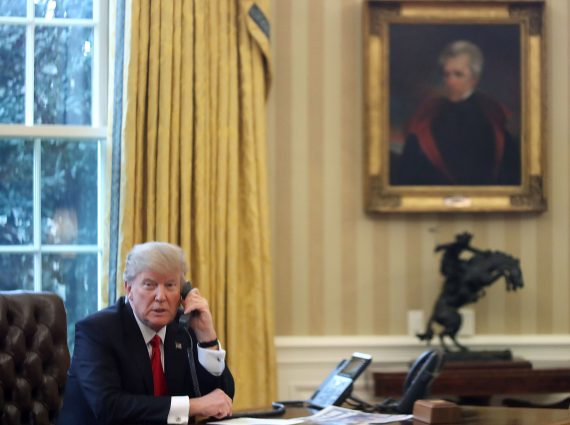
President Donald Trump (Credit: Getty Images)
“Does the administration do things that create uncertainty that may push people in the other direction [and] make them less optimistic? Yes, it’s possible for him to kill his own rally,” said Mark Calabria, director of financial regulation studies at the Cato Institute, a libertarian think tank in Washington, D.C.
Case in point: The Monday after Trump announced his controversial travel ban — a move that prompted widespread protests at airports across the country and sent waves of panic across the globe — the Dow and S&P 500 logged their worst day since his victory. The market is still up since Trump’s election, and when it comes to his overall deregulation push, Wall Street and the financial industry are largely enthusiastic.
Related: The Goldman alumni and other players on Trump’s team
And if Wall Street thrives, New York City real estate is very likely to benefit.
“All roads lead to Wall Street,” said Nikki Field [TRDataCustom], a leading luxury residential broker at Sotheby’s International Realty. “It’s the largest economic indicator in the real estate market.”
This month, The Real Deal looked at the potential impact that looser Wall Street restrictions could have on several key areas of NYC’s real estate market — office leasing, luxury condo sales and real estate finance, where the city’s top investment banks all play a key role.
Not only are those banks a big source of funding for large development projects, they also provide mortgages to residential buyers across the market and take up office space in many of the city’s trophy office towers. That’s not to mention that many of their executives are also purchasing multimillion-dollar luxury condos for themselves.
In 2010, in the wake of the Great Recession, President Barack Obama signed the Dodd-Frank Wall Street Reform and Consumer Protection Act to put checks on big banks.
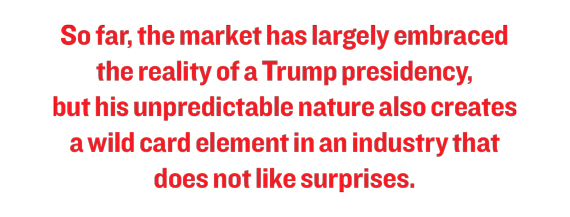 Whether Trump — who called the law a “disaster” last month and vowed to “do a number on it” — can defang those regulations and unshackle Wall Street again is yet to be seen. But the prospect of some sort of change is already shifting the industry’s mindset.
Whether Trump — who called the law a “disaster” last month and vowed to “do a number on it” — can defang those regulations and unshackle Wall Street again is yet to be seen. But the prospect of some sort of change is already shifting the industry’s mindset.
“If this new administration decides to gut the legislation or make significant changes that allow Wall Street firms to seek out more profitable ventures, do their own trading and move back towards what we had before, that could be very beneficial,” said John Challenger, CEO of the Chicago-based executive recruitment firm Challenger, Gray & Christmas.
“That holds real promise for bonuses to be unleashed, and the real estate market could be the beneficiary,” he added.
The boost to the industry is already being seen on the ground.
In 2016’s fourth quarter, the five biggest U.S. investment banks — Goldman Sachs, JPMorgan, Citigroup, Bank of America and Morgan Stanley — reported a combined $18.1 billion in trading revenue. That was a 26 percent year-over-year increase and the best fourth quarter for Wall Street since 2007.
Still, while Wall Street clearly welcomes Trump’s planned corporate tax cuts and deregulation, the industry is less enthusiastic about his trade policy.
Trump has already signed an executive order to pull out of the 12-nation Trans-Pacific Partnership trade deal, and floated a 20 percent tax on imports from Mexico to pay for his planned border wall.
“Entering into a trade war is the fastest way to get us into a recession,” said Chris DeMuth, founder of the Connecticut-based investment firm Rangeley Capital.
Not only would that weaken consumers’ purchasing power, it would also have a “massive impact on [big banks] that underwrite these [trade] deals,” DeMuth said.
In addition, some experts argue that significantly scaling back Dodd-Frank could put the country at risk of another major downturn — something on par with the 2008 crisis, which caused residential real estate prices in some NYC sectors to tank by as much as 25 percent and closing volume to plummet by 50 percent in the dark days of 2009. And New York prices on both the residential and commercial sides of the market have been sliding since 2015, creating concern that another downturn could already be in motion.
Even some of the biggest CEOs in the business say Dodd-Frank should not be entirely trashed.
“We’re not asking for a wholesale throwing out of Dodd-Frank,” JPMorgan CEO Jamie Dimon said during a conference in December, according to news reports. Instead, banks are asking for elements of the law to be scaled back.
The Cato Institute’s Calabria — who was a staffer on the Senate Banking Committee from 2008 to 2009 — noted that “in the short run, many of [Trump’s] policies will still generate a level of uncertainty that will keep people trying to guess.”
Office market anticipation
In the years after the last financial crisis, New York’s big banks shed office space en masse.
But with the financial services industry now rallying, banks and other financial firms are beginning to take more space.
Several top developers and office building owners say they have already seen positive signs trickling into the market.
In late January, Steven Durels, the director of leasing at SL Green Realty, told investors that in 2016’s fourth quarter, he saw financial firms step back into the office market in a big way.
 “Post-election, we certainly saw a bump in activity, tour activity, proposal activity and leases that are being negotiated — [at] 280 Park Avenue in particular,” he said during an earnings call, referring to the Midtown tower that the company owns with Vornado Realty Trust. “Every deal that we’re negotiating right now is a financial services tenant.”
“Post-election, we certainly saw a bump in activity, tour activity, proposal activity and leases that are being negotiated — [at] 280 Park Avenue in particular,” he said during an earnings call, referring to the Midtown tower that the company owns with Vornado Realty Trust. “Every deal that we’re negotiating right now is a financial services tenant.”
The companies have signed some big-ticket tenants recently, including Wells Fargo (which is expanding its existing footprint in the building) and private-equity firm Antares Capital, which signed a 55,000-square-foot lease in December. The building will also be home to the new Four Seasons Restaurant, which is scheduled to open later this year.
Durels said SL Green has also seen increased activity from financial firms at its 37-story Plaza District tower 10 East 53rd Street, which is undergoing a renovation.
“It feels like that sector is back in the market, they’ve got some new enthusiasm and we’re hopeful that we’re going to see more activity throughout the year,” he said.
RXR Realty CEO Scott Rechler, meanwhile, also told TRD that after years of austerity, financial firms are starting to show a greater appetite for space.
In addition to the prospect of deregulation under Trump, many of those companies are betting on rising interest rates, he said, noting that a 1 percent hike in short-term rates can net between $3 and $5 billion in profits for most big banks annually.

Scott Rechler (photo: STUDIO SCRIVO)
“They have just about shed and consolidated all of the space that they can,” Rechler said. “Now there has been a psychological shift from contraction to growth in response to the potential for rising interest rates and the lifting of regulation that has weighed banks down for most of this decade.”
“If this continues, the pendulum will start to swing back towards expansion,” Rechler added.
Expansion decisions, however, often boil down to how many employees are on the payroll. Over the last two years, employment in Manhattan’s securities, commodities and investment sectors has steadily risen, jumping to 171,000 in 2016 from 160,000 in 2014, according to the U.S. Bureau of Labor Statistics.
But that’s still lower than the 180,000-plus logged before the 2008 recession, as well as lower than the peak of roughly 190,000 in 2001.
Ken McCarthy, principal economist at Cushman & Wakefield, said financial service firms account for nearly 11 percent of all jobs in NYC, versus just 5.7 percent of jobs nationally.
“Because they are such a large sector of employment, they are also a large occupier of space. So, anything that impacts financial services will impact the local real estate market,” he said.
Even those who are cautiously optimistic about Trump note that a true boon to the office market could take a year or more — if it happens at all. And some are outright skeptical of the so-called “Trump Bounce.”
Heidi Learner, the chief economist at commercial brokerage Savills Studley, noted that with the exception of JPMorgan, most big banks have seen their global head counts decrease or remain flat in the last few quarters.
She also pointed out that many of the employees that banks have hired in recent years have been in compliance divisions that were beefed up to ensure the institutions are meeting complex government regulations.
“Any reforms that scale back oversight would call into question the need for a lot of workers that have been added over the last several years,” Learner said. “I would argue it could actually lead to a reduction in firms’ needs for office space.”
Joseph Orefice, head of commercial real estate lending at Investors Bank — a publicly traded financial firm with $21 billion in assets and branches throughout New York and New Jersey —noted that when he joined the company in 2009, it had four to five employees charged with compliance. Now it has more than a hundred, not counting outside consultants.
“Not one of those people generates any revenue,” he said.
Learner also noted that certain areas of business that were scaled back because of increased regulations — such as proprietary trading (or investing on behalf of the bank itself rather than an outside client) — are unlikely to come back. Even Trump’s Treasury Security pick Steven Mnuchin, a former Goldman Sachs partner and hedge fund manager, said he backs the Volcker Rule, which restricts that type of speculative investing.
While that may be good for consumers and capping market volatility, it doesn’t bode well for firms taking more office space.
“In order for growing banks to need more square footage, they would likely need to create completely new lines of business,” Learner said. “Just because big investment banks like Goldman and Citigroup are making more money doesn’t mean they need more people — they could just be more profitable.”
 In fact, in 2015, Citigroup announced plans to consolidate its scattered NYC offices. Within the next few years, most of the firm’s New York employees will be moved into its global headquarters at 388 Greenwich Street, which the bank bought back from SL Green last year after selling it to the REIT in 2007. The bank is now in the midst of a multi-year renovation that’s set to be completed in 2019.
In fact, in 2015, Citigroup announced plans to consolidate its scattered NYC offices. Within the next few years, most of the firm’s New York employees will be moved into its global headquarters at 388 Greenwich Street, which the bank bought back from SL Green last year after selling it to the REIT in 2007. The bank is now in the midst of a multi-year renovation that’s set to be completed in 2019.
Gordon Ogden, a principal at Byrnam Wood, a Manhattan-based tenant representative, said he believes all of the new space coming on the market will create an “office space glut.” (The New York Building Congress pegs the amount coming online at 20 million square feet by 2020.)
Ogden also said even when companies grow, they may not need to rent new space because in many cases they are sitting on empty offices that they were opting not to sublease.
And even those who have expressed optimism about Trump’s impact on the market, said so far it’s just hopeful speculation.
“The caveat is that we are still in the honeymoon period [with the new administration],” RXR’s Rechler noted. “For the positive outlook and recent market rally to continue, the optimism for positive change needs to be converted into real change.”
Hello, Wall Street buyers
Since Trump’s victory, Morgan Stanley’s CEO, James Gorman, has sold off some $8.4 million in stocks.
And Gorman is not the only Wall Street bigwig who’s been cashing out as the financial markets reach multi-year highs. According to a review of securities filings by the Wall Street Journal, top executives at big banks sold close to $100 million in stock between the Nov. 8 election and Jan. 23 — the most of any period in more than a decade.
With bankers’ wallets getting fatter, some real estate insiders said they’re already seeing signs that much of that cash will get parked in NYC’s luxury residential market.
Financial executives — who have pulled back from the high-end condo market in the last few years — are now suddenly perusing open houses and calling brokers to inquire about properties again, sources told TRD.
“It’s gratifying to see Morgan Stanley, Goldman Sachs and Wells Fargo walking in here and putting their money where their mouth is,” said Sherry Tobak, senior vice president at Related Sales, who is leading residential sales at the under-construction 15 Hudson Yards office-and-condo tower.
She said the 285-unit tower, which is being developed by Related Companies and Oxford Properties, has seen 75 deals at an average price of about $5 million since launching sales in mid-September.
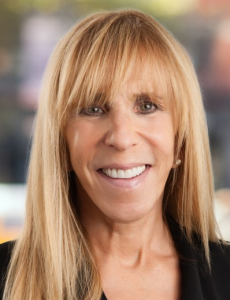
Sherry Tobak
Tobak said that a “huge percentage” of buyers at Hudson Yards are from the financial services industry. That’s a change from previous years, when a greater number of her clients came from overseas, she said.
While high-profile Wall Street executives are always going to be buying big-ticket NYC condos, many of the flashier deals of this cycle have involved foreign billionaires from China, Saudi Arabia and other countries. Even at a lower price point, between $2 and $10 million, Wall Street buyers have played less of a role over the past few years.
“When’s the last time you saw a Goldman Sachs guy buy?” said Donna Olshan, president of the residential brokerage Olshan Realty, referring to the ultra-luxury segment of the market. “Wall Street got repriced and there just weren’t that many people making that much money anymore.”
Wall Street bonuses are, in fact, expected to be down 10 percent for 2016, marking the third straight annual drop.
Still, Nicole Grandelli of Stribling & Associates said she suddenly began receiving calls from Wall Street clients in the weeks following the election, when the market was rallying.
“When the market was flat last year, people felt uneasy about liquidating their stock portfolios and transitioning it into real estate,” Grandelli said. “Now that their portfolios are on a positive upswing, they feel more comfortable.”
On the flip side, however, foreign buyers, could get turned off by Trump’s latest travel ban, which targets Muslim-majority countries.
“It throws a huge question mark into the perception that has fueled this market for so long — that we’re a welcoming environment for non-U.S. investment,” said Stuart Siegel of Engel & Völkers. “You’ve got to start to wonder what the impact will be for non-U.S. students wanting to study here and how their parents will feel about buying apartments for them.”
And the financial services industry is certainly not rock solid.
Deutsche Bank, for one, announced in mid-January that a number of its senior employees would not receive bonuses for 2016, as the financial giant looks to recoup money it lost from low interest rates and ongoing legal troubles. Meanwhile, Morgan Stanley cut bonuses for its investment bankers by roughly 15 percent, according to news reports.
Nonetheless, Stribling broker Jason Lanyard said additional interest-rate hikes — the Fed raised rates by a quarter percentage point in December and is expect to further nudge rates up this year — may also push more Wall Street executives into the NYC real estate market, since they are typically among the highest leveraged buyers.
“If you’re buying in the $5-million-to-$10-million range, you could be talking about a difference in purchasing power of over $500,000 based on the mortgage payments,” Lanyard said.
In general, the environment is likely to be friendly to Wall Streeters.
Sources also say they expect any outcry over executive pay be tamped down under Trump.
In 2015, the U.S. Securities and Exchange Commission adopted new rules under Dodd-Frank that require public companies to disclose the ratio of their CEO’s pay to the median pay of their other employees. The rule is slated to go into effect this year.
But Trump could try to scrap that Obama-era effort.
“Trump has been loath to disclose his own finances, so he might get rid of those laws,” Challenger said. “He never made Wall Street the bad guy or the focus on his attacks. He focused his attacks more overseas.”
While the stock market is still up, some say that on the residential side this recent bump in Wall Street buyers could be temporary.
“With these guys, it’s like a game of ping-pong,” Olshan said. “One day, they’re feeling rich and on top of the world. The next, they’re down in the dumps again.”
The new lending game
Under the Obama administration, big Wall Street firms and other banks increasingly played a smaller role in financing NYC’s ground-up condo and commercial developments amid stricter regulations.
But some think that could change in the Trump years.
David Blatt, of the investment banking firm CapStack Partners, argued that he expects banks to get more aggressive on construction financing immediately if Trump pushes through looser regulations. “Right out of the gate we could see that happening, particularly in the small-asset space,” he said.
While few expect dramatic shifts in real estate lending immediately, and many point out that economic cycles and investor confidence still play a greater role than regulatory changes, there is something of a consensus that a pro-Wall Street shift in Washington could lure banks back into some of the arenas they eschewed in recent years.
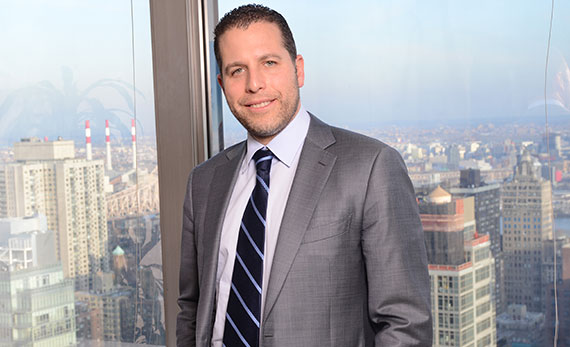
Madison Realty Capital’s Josh Zegen (credit: Chance Yeh)
“It’s a pendulum swung too far one way, but it will flip back a little bit” under Trump, said Josh Zegen, co-founder of the non-bank lending and investment firm Madison Realty Capital.
To be clear, banks didn’t disappear from the commercial real estate market in recent years. In the last two years, traditional banks actually increased their share of the pie of all U.S. commercial real estate loans, providing 45 percent of loans in 2016, up from 32 percent in 2014, according to research firm Real Capital Analytics. But that increased lending was largely made up of less risky real estate loans — rather than loans on construction projects, where banks have had to meet more government requirements.
“The entire world of bank lending is completely upside down,” New York developer Bruce Eichner told TRD. “As a result of all of the regulation, the banks for all intents and purposes cannot — or will not — loan more than $75 million for any [construction] project.”
Eichner noted that developers with large projects now need to include multiple banks. “It’s worse than herding cats and dogs,” he said.
Still, Eichner predicted that in the second half of 2017, banks will become more active construction lenders as demand for new buildings begins to outpace supply following the recent slowdown in newly issued condo permits.
But if banks do jump back in, they’ll have to compete with a slew of new alternative or “shadow” lenders that have stepped into the market when they pulled back, including debt funds, mortgage REITs, private equity firms, crowdfunding startups, small out-of-town banks and even developers.
The annual capital raised by U.S. real estate debt funds alone jumped to $16.4 billion in 2016, up from $3.5 billion in 2010, according to research firm Preqin, which focuses on the alternative assets industry.
New regulations enacted in the Obama years “raised the cost of lending in the regulated part of the system and shifted credit to the shadow system,” said Mark Zandi, chief economist at Moody’s Analytics.
Boyd Fellows, managing partner at private lender ACORE Capital, added that stricter regulation “obviously creates a competitive advantage” for non-bank lenders like his firm.
Ironically, most non-bank debt providers finance their lending with credit lines from major banks. This means that banks still carry some of the lending risk, but regulators are satisfied because corporate credit lines are deemed less risky than construction loans, sources say.
But with signs emerging that the regulatory tide is about to change, the Trump administration could attempt to alter the financial incentives for real estate lending.
Walter “Jay” Clayton — Trump’s pick to head the SEC — is widely expected to be more lenient on Wall Street than his predecessor, Mary Jo White, a former federal prosecutor. And Trump gave him a broad mandate to “undo many regulations which have stifled investment in American businesses.”
Trump’s Treasury Secretary nominee, Mnuchin, would not directly regulate banks, but would “set a lot of the tone” on regulations, as one source put it.
The Treasury also plays a key role in the Financial Stability Oversight Council — a government organization established by Dodd-Frank — which judges banks on their systemic risk to the economy. And it has prosecuted financial firms alongside the Federal Reserve and the Justice Department for alleged misconduct.
Wall Street banks have paid tens of billions of dollars in mortgage-related settlements connected to toxic securities since 2012.
But those types of prosecutions are expected to be less of a concern under Trump.
Some sources note that portions of Basel III — the voluntary global regulatory guidelines for banks — could have a far bigger impact on real estate lending than Dodd-Frank.
For example, the High Volatility Commercial Real Estate rules, which went into effect in January 2015, stipulate that for certain risky real estate loans, such as construction loans, a developer needs to have invested 15 percent of a project’s estimated value.
If a sponsor is building a condo project with a $300 million sellout, for instance, that developer must invest at least $45 million in equity in the project. If it doesn’t, the bank issuing the construction loan must set aside a larger “capital buffer” than normal. That substantially raises the cost of debt, which in some cases makes construction lending less appealing to banks.
“It’s given us pause,” said one bank executive, who asked to remain anonymous.
But those guidelines were adopted by the Federal Reserve and other U.S. banking regulators, and a leadership change by Trump could open the door to rolling them back.
Governing with Trump
In his first few weeks in office, Trump feverishly signed a string of executive orders. But rolling back Wall Street regulations will take more than inking a signature on a one-man mandate.
Even with Republicans controlling Congress, there would likely be fierce political opposition in Washington and beyond.
Some experts argued that even if Trump were to win part of that fight, a rollback would take several years.
Former Fed Chair Alan Greenspan, who has called Dodd-Frank a “disastrous mistake,” said he doesn’t think Trump will be able to dismantle and repeal it.
“The complexity of unwinding such regulation embedded in the system makes it nearly impossible,” he said last month at a forum in New York, Private Equity Real Estate reported.
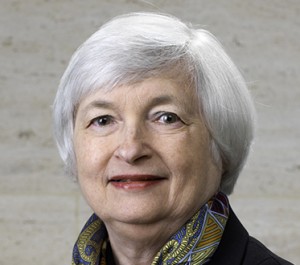
Janet Yellen
Others, including current Fed Chair Janet Yellen and former Fed Chair Ben Bernanke, have defended the legislation.
In the meantime, many are weighing in and attempting to analyze the market rally, a tricky feat especially in this new fast-paced Trump environment where a Twitter war with a foreign leader or another executive order could upend world affairs.
Former Obama Treasury Secretary Larry Summers, a Harvard professor and the school’s former president, recently penned an op-ed in the Washington Post, in which he called the Trump market rally a “sugar high,” noting that “history is replete with authoritarian policies that produced short-run benefits but poor long-run outcomes.”
Summers wrote that while “animal spirits are running hot” that could easily change.
“If ever there were a time to hope for the best but plan for the worst, now is that time,” he concluded.




